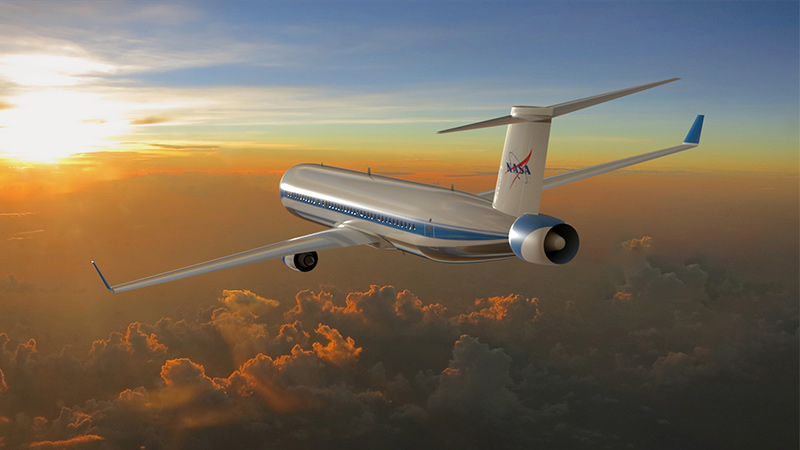Stay Up to Date
Submit your email address to receive the latest industry and Aerospace America news.
NASA last month hired Aurora Flight Sciences to take an independent look at the blueprint of a single-aisle airliner that could burn dramatically less jet fuel than today’s version, before the agency invests further in the concept.
Virginia-based Aurora Flight Sciences was chosen to conduct the study, which runs through June, because both organizations are designing planes with boundary-layer-ingestion propulsion as a fuel reduction strategy. The boundary layer is the slow-moving air flowing along a plane’s fuselage and wings that causes drag and slows the plane. NASA’s proposed design would accelerate that airflow through an electrical ducted fan at the tail, which would be powered with energy from generators attached to gas-fueled jet engines under the wings. This acceleration should reduce drag and the amount of thrust required to fly. Aurora, which became a Boeing subsidiary in November, will analyze the digital modeling of this proposed Single-Aisle Turboelectric Aircraft with Aft Boundary Layer propulsion, called Starc-ABL for short and pictured above. Aurora is designing a separate boundary layer ingestion plane called the D8 in collaboration with the Massachusetts Institute of Technology and Connecticut-based Pratt & Whitney, and with sponsorship from NASA.
NASA needs a second opinion about the Starc-ABL design because there is limited test data to draw on when modeling hybrid-electric power and boundary layer ingestion on aircraft, says Jason Welstead, the technical monitor for the STARC-ABL concept at NASA’s Langley Research Center in Virginia. Engineering obstacles include directing the electricity generated by the wing engines to the ducted tail motor through small wires to avoid the weight of large power cables. The Starc-ABL research is funded by NASA’s Advanced Air Transport Technology Project, which is also separately studying propulsion and energy technology that Welstead and his team will draw from to build the plane one day. Welstead says NASA will schedule future research based on the results of Aurora’s report.
Unlike NASA, Aurora has already built a physical model of the D8, which in 2013 began wind tunnel testing at NASA’s Langley Center. Brian Yutko, Aurora’s vice president of research whose team is conducting the study of the Starc-ABL, says the company won’t propose changes that differ much from NASA’s design.
NASA forecasts that the number of people seeking to fly each day could double by 2035 compared with today’s air travel rate, so the Starc team aims to design aircraft that would meet that rise in demand. If boundary layer ingestion can reduce the amount of fuel burned during flight by 8 to 10 percent, that would give aircraft designers several options to increase the distance of flights, reduce flight costs, or increase fuel efficiency by making additional changes to the air frame, Yutko says.
“Even if individual technologies like [boundary layer ingestion] can only get you the 8 to 10 percent, the indirect benefit can be quite large,” Yutko says. “Things like reduced weight and different fuselage shapes can contribute.” NASA spurred research in boundary layer ingestion in 2008 when it published a research announcement seeking aircraft designs that increased fuel efficiency. Numerous research groups proposed boundary layer ingestion as a means to meet that goal, including a team at MIT that proposed what became the D8.
The Starc-ABL proposal being researched by Aurora is one of a series of turboelectric concept planes under study by NASA, which has not publicly disclosed the rest of the Starc series, Welstead says.
“Air frame and propulsion people have tried to keep things separate so they can minimize interference,” Welstead says, adding that unless they try to move beyond the limited incremental benefits of that traditional design mindset, “we are never going to hit NASA’s aggressive performance goals.”
About Tom Risen
As our staff reporter from 2017-2018, Tom covered breaking news and wrote features. He has reported for U.S. News & World Report, Slate and Atlantic Media.
Related Posts
Stay Up to Date
Submit your email address to receive the latest industry and Aerospace America news.





